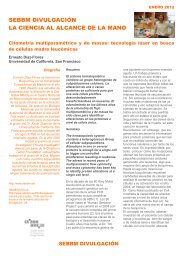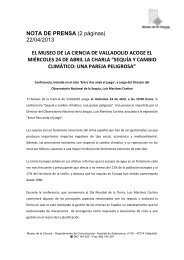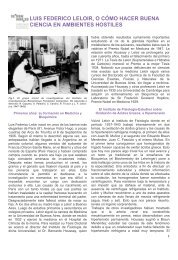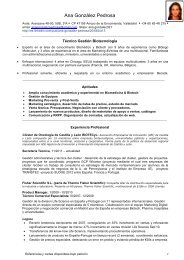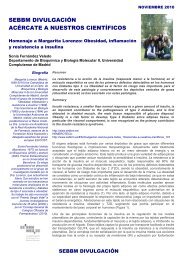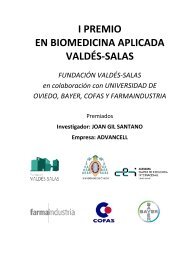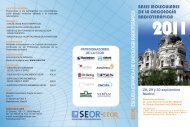The Spanish Society of Biochemistry and Molecular ... - SEBBM
The Spanish Society of Biochemistry and Molecular ... - SEBBM
The Spanish Society of Biochemistry and Molecular ... - SEBBM
Create successful ePaper yourself
Turn your PDF publications into a flip-book with our unique Google optimized e-Paper software.
SPANISH SOCIETY OF BIOCHEMISTRY AND MOLECULAR BIOLOGY<br />
271<br />
always forced to emigrate or could not return. An exception<br />
was Angel Santos (7), a pr<strong>of</strong>essor <strong>of</strong> Biological Chemistry at<br />
the School <strong>of</strong> Pharmacy in Madrid, who taught, carried out<br />
research, <strong>and</strong> lobbied for biochemistry during those bleak years,<br />
being the IUB (now IUBMB) representative <strong>of</strong> Spain since the<br />
incorporation <strong>of</strong> Spain to IUB in 1955, till 1968. Angel Santos<br />
was the mentor <strong>of</strong> many <strong>Spanish</strong> biochemists, including Federico<br />
Mayor Zaragoza, widely known as UNESCO Director General<br />
(1987–1999). By contrast, Francisco Duran-Reynals (8, 9),<br />
the father <strong>of</strong> hyaluronidase <strong>and</strong> a founding father <strong>of</strong> cancer virology,<br />
was set to return to Spain from the Rockefeller Institute,<br />
but the <strong>Spanish</strong> civil war prevented this. Jordi Folch-Pi (9, 10),<br />
the creator <strong>of</strong> the chlor<strong>of</strong>orm–methanol extraction procedure,<br />
the discoverer <strong>of</strong> proteolipids <strong>and</strong> a father <strong>of</strong> Neurochemistry,<br />
went from Barcelona to Duran-Reynalds laboratory in the Rockefeller<br />
in 1936, <strong>and</strong> remained in the USA for the rest <strong>of</strong> his<br />
highly successful scientific life. In the Medical School <strong>of</strong> Valencia,<br />
the physiologist José García Blanco, trained with Negrín in<br />
Madrid <strong>and</strong> with Knoop in Germany, carried out some modest<br />
biochemical work <strong>and</strong> proposed a then very young Santiago<br />
Grisolía to emigrate to Ochoa’s laboratory in New York (9, 11).<br />
In his 30 years in the USA Grisolia demonstrated biochemically<br />
(together with P.P. Cohen <strong>and</strong> in parallel with Sarah Ratner) the<br />
reality <strong>of</strong> the urea cycle, introduced biochemistry to Kansas,<br />
<strong>and</strong> carried out important work on enzymes <strong>and</strong> on protein<br />
carbamylation. Francisco Gr<strong>and</strong>e Covián was another <strong>of</strong> these<br />
pioneer expatriate biochemists (9). He had worked also with<br />
Negrín before the war, carried out nutritional studies in Valencia<br />
during the war years as part <strong>of</strong> the effort <strong>of</strong> the legal Government<br />
to feed the population, <strong>and</strong> emigrated in 1953 to stay<br />
more than 20 years in the University <strong>of</strong> Minnesota where he<br />
developed a very successful career in nutritional biochemistry<br />
<strong>and</strong> related areas. Others who left the country at that time to<br />
carry out biochemical work (9) were Joan Oró (a founding father<br />
<strong>of</strong> origin <strong>of</strong> life biochemistry) <strong>and</strong> Carlos Villar-Palasí (a<br />
pr<strong>of</strong>essor at the University <strong>of</strong> Virginia with important contributions<br />
on glycogen metabolism <strong>and</strong> on kinases). Pedro Cuatrecasas,<br />
one <strong>of</strong> the first Pharmaceutical biochemists <strong>and</strong> a father <strong>of</strong><br />
affinity chromatography, was born in Madrid amid the civil<br />
strife, but his family soon fled the country. Marino Martínez-<br />
Carrión also developed his entire scientific career abroad, graduating<br />
from Berkeley <strong>and</strong> participating in the development <strong>of</strong><br />
biophysical biochemistry, first in the Medical College <strong>of</strong> Virginia<br />
<strong>and</strong> later in Kansas City (Missouri).<br />
ALBERTO SOLS, AND THE BIRTH OF SEB (<strong>SEBBM</strong>)<br />
AND FEBS<br />
Alberto Sols deserves a particular mention (12, 13). An<br />
M.D. in 1944, he was on good terms with the regime <strong>and</strong> spent<br />
3 years (1951–1954) in St. Louis with the Nobel Laureates in<br />
Physiology or Medicine (1947) Carl <strong>and</strong> Gerty Cori (14, 15).<br />
<strong>The</strong> laboratory <strong>of</strong> the Coris was then a Mecca for enzymology<br />
<strong>and</strong> for carbohydrate biochemistry, <strong>and</strong> thus, in addition to perfecting<br />
enzymology, Sols then made very good international<br />
contacts with many leading scientists on both sides <strong>of</strong> the Atlantic.<br />
Sols also developed a close relationship with Ochoa <strong>and</strong><br />
with the Argentinean scientist Luis Leloir, who would be later a<br />
Nobel Laureate in Chemistry (1970). Sols returned in 1954 to<br />
Madrid <strong>and</strong> developed his career in the CSIC under the protection<br />
<strong>of</strong> Albareda (at that time in Spain, protection from a big<br />
shot was a prerequisite for advance). His endeavors proved very<br />
good for <strong>Spanish</strong> <strong>Biochemistry</strong>, because he was the right man<br />
at the right place <strong>and</strong> time. Being, in a way, the internationally<br />
well known <strong>Spanish</strong> Biochemist <strong>of</strong> the time, he helped to open<br />
the windows to the external world. After years <strong>of</strong> stagnation<br />
<strong>and</strong> international isolation, Spain began to return to the international<br />
forums in 1953, when a treaty was signed with the USA,<br />
which was followed little later by the entry <strong>of</strong> the country into<br />
the UN (1955) <strong>and</strong> by the launching <strong>of</strong> the 1st <strong>Spanish</strong> Development<br />
Plan (1963) including the allocation <strong>of</strong> money for science.<br />
<strong>The</strong> country was in need <strong>of</strong> international connections, <strong>and</strong><br />
in the biochemical context, it already had a representative to the<br />
recently created IUB (16). Alberto Sols, together with no more<br />
than another 34 biochemists/physiologists, helped these connections,<br />
in large part by creating SEB (now <strong>SEBBM</strong>), the <strong>Spanish</strong><br />
<strong>Society</strong> <strong>of</strong> <strong>Biochemistry</strong> in 1963 (17), the same year that FEBS<br />
(the Federation <strong>of</strong> the European Biochemical Societies) was<br />
created (18). In this way, SEB was a founder <strong>of</strong> FEBS. In addition,<br />
SEB became the <strong>Spanish</strong> Adhering Body to IUB, <strong>and</strong>, in<br />
fact, Sols was the <strong>Spanish</strong> representative in IUB from 1968<br />
to 1972.<br />
TOWARDS INTERNATIONALIZATION OF<br />
SPANISH BIOCHEMISTRY<br />
<strong>The</strong> creation <strong>of</strong> <strong>SEBBM</strong> (I will use from here on the modern<br />
term for this society, which includes also molecular biology, as<br />
I will use IUBMB rather than IUB) was a turning point in the<br />
scientific life <strong>of</strong> Spain <strong>and</strong> in the internationalization <strong>of</strong> <strong>Spanish</strong><br />
biological science (17). It meant the separation <strong>of</strong> biochemistry<br />
from physiology in <strong>Spanish</strong> Universities, allowing biochemistry,<br />
<strong>and</strong> later on, molecular biology, to flourish. In 1966, when I<br />
entered Medical School in Valencia, it was clear to us that biochemistry<br />
was becoming the language <strong>of</strong> medicine. In my view,<br />
<strong>SEBBM</strong> was highly successful in spreading by way <strong>of</strong> its members<br />
a new creed <strong>of</strong> passion for underst<strong>and</strong>ing <strong>and</strong> for hard<br />
work, <strong>and</strong> the positivist utopia that the underst<strong>and</strong>ing <strong>of</strong> life<br />
was essential for a better life (perhaps a naïve concept; nevertheless,<br />
I still firmly believe in it). To us, this creed was very<br />
welcomed in those days <strong>of</strong> revolt against an authoritarian rule<br />
because <strong>of</strong> its reliance on reason rather than on authority.<br />
HELP FROM THE OUTSIDE AND THE<br />
GROWTH INSIDE<br />
Since its very beginning, <strong>SEBBM</strong> <strong>and</strong> the development <strong>of</strong><br />
<strong>Spanish</strong> biochemistry <strong>and</strong> molecular biology were helped by the<br />
<strong>Spanish</strong> biochemist expatriates. Severo Ochoa (19) <strong>and</strong> Santiago



